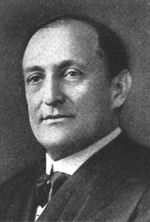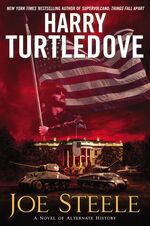| ||||||||||||||||||||||||||||||||||||||||||||||||
James Clark McReynolds (February 3, 1862 – August 24, 1946) was an American lawyer and judge who served both as United States Attorney General under President Woodrow Wilson and as an Associate Justice of the United States Supreme Court.
McReynolds served on the Court from October 12, 1914 to his retirement on January 31, 1941, and was known for his conservative opinions opposing President Franklin D. Roosevelt's New Deal legislation. He is also generally remembered as one of the most unpleasant people to serve in the Court's recent history. While an anti-Semite and misogynist, McReynolds seemed incapable of getting along with anyone. However, he did have an affinity for children, and in his remaining years, adopted 33 children left orphaned during the German bombing of London.
James McReynolds in Joe Steele
Justice James McReynolds (1862-1934) was one the so-called "Supreme Court Four", a group of justices on the United States Supreme Court who overturned most of the legislation passed as part of President Joe Steele's Four Year Plan.[1] In response, Steele conferred with Bureau of Investigation Chief J. Edgar Hoover to investigate the justices.[2] Then Steele gave a radio speech in which he denounced the Supreme Court as nine old men who were not elected, and who were actively wrecking the country. Steele implied the Court's actions were deliberate, and promised that there would be an investigation.[3]
Hoover discovered "evidence" that four justices, McReynolds, Pierce Butler, Willis Van Devanter, and George Sutherland, were in fact colluding with Nazi Germany against the United States. In February, 1934, Hoover led a group of agents to very publicly arrest the Supreme Court Four for treason while they were in the middle of deliberations.[4] For good measure, President Steele suspended the writ of habeas corpus immediately after, insuring that the Four remained in custody until their trial.[5]
The Four faced a military tribunal in September 1934. Upon the beginnings of the proceedings, Justice James McReynolds informed the tribunal that he wished to enter a guilty plea and throw himself upon their mercy. The ACLU attorney's attempted to object, claiming the confession was coerced, which Attorney General Andy Wyszynski denied. Captain Raymond A. Spruance questioned McReynolds, who denied any coercion and claimed he received adequate treatment. Spruance then turned to the other three judges, who also admitted their guilt. McReyolds stated for the record that they believed that Steele was the "American Trotsky",[6] and that colluding with the Nazis was the best way to keep the U.S. a democracy.[7] Justice Sutherland added that they weren't the only ones, and named Louisiana Senator Huey Long and radio personality and Steele critic, Father Coughlin.[8]
The tribunal went into recess to deliberate. That afternoon, the tribunal unanimously found the Four guilty, and sentenced them to execution by firing squad.[9] Their attorneys pledged to appeal. With few options, the ACLU appealed to the remaining Supreme Court and to President Steele, and published letters in the newspapers.[10] Ultimately, Steele denied their appeal, and the Four were executed at sunrise some weeks after their conviction. McReynolds was the only one to make a sound when he died.[11]
Literary comment
In the short story, James McReynolds and the other judges are called the "Gang of Four", but meet the exact same fate as in the novel. Their trial is more detailed in the novel.
James McReynolds in Southern Victory
James McReynolds was the last Chief Justice of the Supreme Court of the Confederate States of America.
McReynolds and the Supreme Court effectively sealed their fate when they stymied Freedom Party leader and future President Jake Featherston's bid for the office in 1927 by ruling that Burton Mitchel, who'd been elected Vice President in 1921, and ascended to the presidency upon the murder of his predecessor, Wade Hampton V, could run again in his own right.[12] Mitchel won handily in 1927.[13] However, with the onset of the stock market crash in 1929, Mitchel and the Whigs, unable to present working solutions to the country's economic depression, grew unpopular.[14] Featherston capitalized on this and was elected in 1933.[15] McReynolds administered the oath office to the new president in 1934.[16]
Almost immediately, Featherston forced a showdown with the Court, passing legislation in 1934 for internal dam building projects that did not aid navigation, as required by the CS Constitution.[17] As expected, the Court held the legislation unconstitutional.[18] Featherston and Attorney General Ferdinand Koenig promptly abolished the Court, using the fact that, despite the constitutional requirement that the CS have a supreme court, one had not been established until May 27, 1866 (nearly four years after the CS won the War of Secession).[19]
Outraged, McReynolds personally visited the Gray House and confronted both Featherston and Koenig.[20] McReynolds expected a heated argument on legal and political issues and was ready for one. But he did not expect a direct, explicit physical threat from Featherston, who made it clear that he'd kill McReynolds if he kept up his oppposition.[21] Not only was Featherston ready to carry out this threat, but the fact of his making it in itself told McReynolds that the political and judicial milieu in which he used to live no longer existed. McReynolds saw no choice but endorse Koenig's semi-judicial argument that the abolition of the Supreme Court was technically valid.[22] Thus, the Supreme Court of the Confederate States of America ceased to exist in 1935.
References
- ↑ Joe Steele, pgs. 71-72.
- ↑ Ibid., pg. 73-74.
- ↑ Ibid., pgs. 76-77.
- ↑ Ibid., pgs. 83-84.
- ↑ Ibid., pgs. 87-89.
- ↑ Ibid., pg. 104.
- ↑ Ibid., pg. 105.
- ↑ Ibid.
- ↑ Ibid., pg. 107.
- ↑ Ibid., pg. 111.
- ↑ Ibid., pgs. 117-118.
- ↑ The Center Cannot Hold, pgs. 177-178.
- ↑ Ibid., pg. 189.
- ↑ Ibid., pg. 247.
- ↑ Ibid., pg. 472.
- ↑ Ibid., pg. 501-503
- ↑ The Victorious Opposition, pgs. 33-34.
- ↑ Ibid., pg. 52.
- ↑ Ibid., pgs. 86-87.
- ↑ Ibid., pg. 86-91.
- ↑ Ibid., pg. 91.
- ↑ Ibid.
| Political offices (OTL) | ||
|---|---|---|
| Preceded by Horace Harmon Lurton |
Associate Justice of the United States Supreme Court 1914-1941 |
Succeeded by James Byrnes |
| Preceded by George W. Wickersham |
United States Attorney General 1913-1914 |
Succeeded by Thomas W. Gregory |
| Political offices (Joe Steele) | ||
| Preceded by Horace Harmon Lurton |
Associate Justice of the United States Supreme Court 1914-1934 |
Succeeded by Unknown |
| Political offices (Southern Victory) | ||
| Preceded by Unknown |
Chief Justice of the Confederate States Supreme Court 19??-1935 |
Succeeded by Office abolished |
| |||||||||||||||||||












